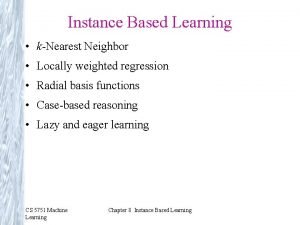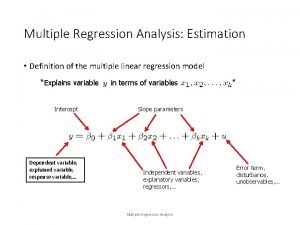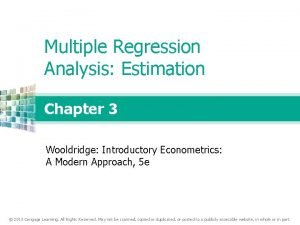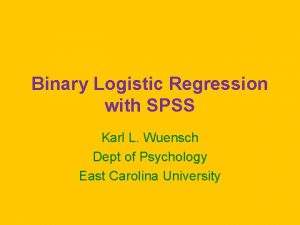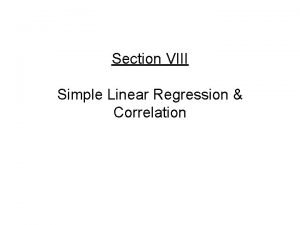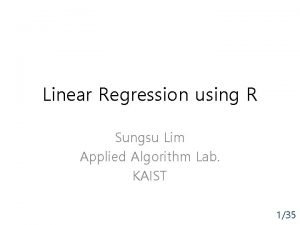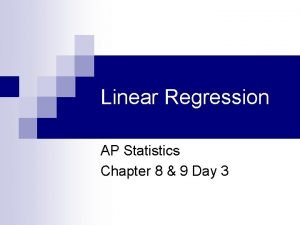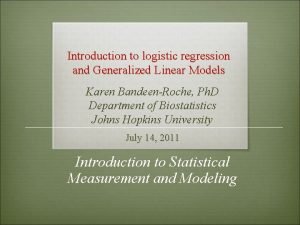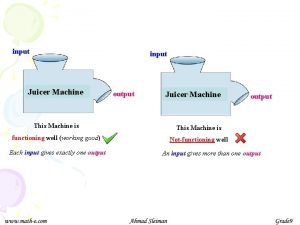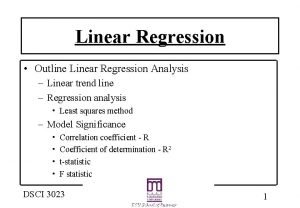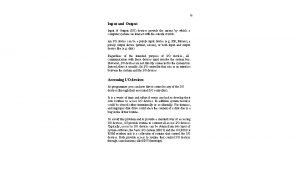Input output Prediction Estimation Machine Learning Linear Regression



















![Tensorflow (텐서플로) • tf. abs ( [+] absolute : 절댓값 ) abs( ) x, Tensorflow (텐서플로) • tf. abs ( [+] absolute : 절댓값 ) abs( ) x,](https://slidetodoc.com/presentation_image_h/0f827b5028f128748394785540e28d71/image-20.jpg)
![Tensorflow (텐서플로) • tf. abs ( [+] absolute : 절댓값 ) v = tf. Tensorflow (텐서플로) • tf. abs ( [+] absolute : 절댓값 ) v = tf.](https://slidetodoc.com/presentation_image_h/0f827b5028f128748394785540e28d71/image-21.jpg)






![Tensorflow (텐서플로) • tf. accumulate_n() Ø tf. accumulate_n([v 1, v 2], shape=[2, 2], tensor_dtype=np. Tensorflow (텐서플로) • tf. accumulate_n() Ø tf. accumulate_n([v 1, v 2], shape=[2, 2], tensor_dtype=np.](https://slidetodoc.com/presentation_image_h/0f827b5028f128748394785540e28d71/image-28.jpg)
![Tensorflow (텐서플로) • tf. accumulate_n() def main(): vec_1 = np. array([[1, 2], [3, 4]]) Tensorflow (텐서플로) • tf. accumulate_n() def main(): vec_1 = np. array([[1, 2], [3, 4]])](https://slidetodoc.com/presentation_image_h/0f827b5028f128748394785540e28d71/image-29.jpg)

















- Slides: 46




기계학습이란? • 지도학습 세부 분류 - 훈령용 데이터에 알고리즘을 적용하여 함수를 추론, 추론된 함수를 통해 컴퓨터가 알아서 답을 찾도록 만드는 것, 지도학습은 명확한 Input과 output이 존재 예측, 추정 기계학습 (Prediction, Estimation) (Machine Learning) . Linear Regression (선형회귀). Regression Tree, Model Tree (회귀 나무). SVN (Support Vector Machine) (서포트 벡터 머신) 지도학습 (Supervised learning) . Neural Network, Deep Learning (신경망). ARIMA, Exponential Smoothing 분류 (Classification) Decision Tree (의사 결정 나무) Logistic Regression, Discriminant Analysis k-NN (k-Nearest Neighbor) Naive Bayes Classification SVM

기계학습이란? • 비지도학습 세부 분류 - 특성이 비슷한 데이터를 합쳐서 군(Group)으로 분류하는 학습 방법, 결과 정보가 없는 데이터들에 대해 특정 패턴을 찾는 것 레이블이 없는 데이터를 사용하는데, 목적은 데이터 안에서 어떤관계(Relationships)를 찾는데 있음, 즉 사람이 개입하지 않고 컴퓨 터 스스로 데이터를 훈련하는 것 패턴/구조 발견 기계학습 (Pattern/Rule) (Machine Learning) => Association Rule Analysis, Sequence Analysis => Network Analysis, Link Analysis, Graph theory => Structural Equation Modeling, Path Analysis 비지도학습 (Unsupervised learning) 그룹화 (Grouping) => k-Means Clustering, Hierarchical Clustering, Density-based Clustering, Fuzzy Clustering => SOM(Self-Organizing Map) (Dimesion Reduction) => PCA(Principal Component Analysis), Factor Analysis, SVD(Singular Value Decomposition) 영상, 이미지, 문자 => Wavelet/Fast Fourier Transformation 자원축소 (Dimesion Reduction) => Text mining


Tensorflow (텐서플로) • 텐서플로우의 자료형 Ø 상수형(Constant) tensorflow. constant(value, dtype=None, shape=None, name="Const", verify_shape=False) 1 2 3 1 value 상수 값 2 dtype 상수의 데이타 형, ex: 실수, 정수 3 shape 행렬의 차원을 정의 4 name은 이 상수의 이름을 정의 4 5

Tensorflow (텐서플로) • 텐서플로우의 자료형 e. g import tensorflow as tf def main(): s = tf. constant(10, dtype=tf. int 16, shape=(1, ), name="Constant_number", verify_shape=False) print (s) if __name__ == "__main__": main() Tensor("Constant_number: 0", shape=(1, ), dtype=int 16)

Tensorflow (텐서플로) • 그래프와 세션의 개념 s 1 = tf. constant(10, dtype=tf. int 16, shape=(1, ), name="Constant_number", verify_shape=False) s 2 = tf. constant(11, dtype=tf. int 16, shape=(1, ), name="Constant_number", verify_shape=False) s 3 = tf. constant(12, dtype=tf. int 16, shape=(1, ), name="Constant_number", verify_shape=False) d = (s 1+s 2)*s 3 s 1 s 2 s 3 + *

Tensorflow (텐서플로) • 그래프와 세션의 개념 Ø 세션(Session)을 생성하여, 그래프를 실행 s 1 = tf. constant(10, dtype=tf. int 16, shape=(1, ), name="Constant_number", verify_shape=False) s 2 = tf. constant(11, dtype=tf. int 16, shape=(1, ), name="Constant_number", verify_shape=False) s 3 = tf. constant(12, dtype=tf. int 16, shape=(1, ), name="Constant_number", verify_shape=False) d = (s 1+s 2)*s 3 sess = tf. Session() result = sess. run(d) print (result)


Tensorflow (텐서플로) • Tensor. Flow Mechanics

Tensorflow (텐서플로) 동작을 정의한 것 • Tensor. Flow Mechanics operation 그래프 operation edge : Node와 Node를 연결 operation 정의를 포함한 것 Node

Tensorflow (텐서플로) • Tensor. Flow Mechanics import tensorflow as tf Ø 위처럼 Tensor. Flow 일단 import 하면 내부적으로 default_graph_stack에 Default Graph가 생긴 다. tf. get_default_graph() 명령어로 접근 가능 graph = tf. get_default_graph() input = tf. constant(value=4. 9, dtype=tf. float 32, shape=(1, ), name="My_number 1") input 2 = tf. constant(value=4, dtype=tf. int 64, shape=(1, ), name="My_number 2") operations = graph. get_operations() for i in range(2): print (operations[i]. node_def)

name: "My_number 1" op: "Const" attr { key: "dtype" value { type: DT_FLOAT } } attr { key: "value" value { tensor { dtype: DT_FLOAT tensor_shape { dim { size: 1 } } float_val: 4. 900000095367432 } } } name: "My_number 2" op: "Const" attr { key: "dtype" value { type: DT_INT 64 } } attr { key: "value" value { tensor { dtype: DT_INT 64 tensor_shape { dim { size: 1 } } int 64_val: 4 } } }

Tensorflow (텐서플로) • #tf. constant : 말 그대로 상수입니다. import tensorflow as tf def main(): hello = tf. constant('Hello. Tensor. Flow') # Tensor("Const: 0", shape=(), dtype=string) print (hello) if __name__ == "__main__": main()

Tensorflow (텐서플로) • tf. add import tensorflow as tf def main(): v 1 = tf. constant(10) v 2 = tf. constant(32) v 3 = tf. add(v 1, v 2) print ("{} + {} = {}". format(v 1, v 2, v 3)) sess = tf. Session() print (sess. run([v 1, v 2, v 3])) # [10, 32, 42] sess. close() if __name__ == "__main__": main()

Tensorflow (텐서플로) • tf. reduce_mean(d) Ø 데이터 값의 평균 import tensorflow as tf import numpy as np def main(): d = [float(m) for m in range(10, 20)] print ("d => {}". format(d)) ave = tf. reduce_mean(d) sess = tf. Session() data = sess. run(ave) print ("ave => {}". format(data)) sess. close()

Tensorflow (텐서플로) • Placeholders import tensorflow as tf def main(): a = tf. placeholder(tf. float 32) b = tf. placeholder(tf. float 32) adder_node = a+b sess = tf. Session() print (sess. run(adder_node, feed_dict={a: 3, b: 4})) print (sess. run(adder_node, feed_dict={a: [1, 2, 3], b: [4, 5, 6]})) sess. close() if __name__ == "__main__": main()
![Tensorflow 텐서플로 tf abs absolute 절댓값 abs x Tensorflow (텐서플로) • tf. abs ( [+] absolute : 절댓값 ) abs( ) x,](https://slidetodoc.com/presentation_image_h/0f827b5028f128748394785540e28d71/image-20.jpg)
Tensorflow (텐서플로) • tf. abs ( [+] absolute : 절댓값 ) abs( ) x, name=None • Args Ø x : type => float 32, float 64, int 32, int 64, complex 128 Ø name => A name for the operation (optional) • Returns Ø complex 64, complex 128
![Tensorflow 텐서플로 tf abs absolute 절댓값 v tf Tensorflow (텐서플로) • tf. abs ( [+] absolute : 절댓값 ) v = tf.](https://slidetodoc.com/presentation_image_h/0f827b5028f128748394785540e28d71/image-21.jpg)
Tensorflow (텐서플로) • tf. abs ( [+] absolute : 절댓값 ) v = tf. constant(value=-10. 0, dtype=np. float 32) pprint(v) # <tf. Tensor 'Const: 0' shape=() dtype=float 32> sess = tf. Session() r = sess. run(v) pprint("r => {}". format(r)) positive_r = tf. abs(r) positive_r = sess. run(positive_r) pprint("positive_r => {}". format(positive_r)) sess. close()

Tensorflow (텐서플로) • tf. complex( real, imag, name=None ) Ø real : A Tensor. Must be one of the following types: float 32, float 64 Ø imag : A Tensor. Must have the same type as real Ø name: A name for the operation (optional) Ø Returns: A Tensor of type complex 64 or complex 128.

Tensorflow (텐서플로) • tf. complex import tensorflow as tf import pprint as ppr def main(): v = tf. complex(real=12. 0, imag=24. 0, name=None) print (v) # Tensor("Complex: 0", shape=(), dtype=complex 64) sess = tf. Session() complex 01 = sess. run(v) (12+24 j) pprint(complex 01) sess. close() if __name__ == "__main__": main()

Tensorflow (텐서플로) • tf. complex

Tensorflow (텐서플로) • tf. complex import tensorflow as tf import pprint as ppr def main(): t_complex 01 = tf. complex(real=23. 4, imag=45. 2, name=None) t_complex 02 = tf. complex(real=12. 23, imag=-34. 0, name=None) print ("complex 01 => {}ncomplex 02 => {}". format(t_complex 01, t_complex 02)) sess = tf. Session() Complex. V = sess. run([t_complex 01, t_complex 02]) # 반드시 리스트로 묶어라 Total. Sum = tf. add(t_complex 01, t_complex 02) s = sess. run([Total. Sum]) pprint("{} + {} = {}". format( Complex. V[0], Complex. V[1], s )) sess. close() if __name__ == "__main__": main()

Tensorflow (텐서플로) • tf. complex(real = , imag = ) # study_1 import tensorflow as tf import pprint as ppr def main(): real = tf. constant([2. 25, 3. 25]) # 실수 imag = tf. constant([1. 234, 2. 456]) # 허수 s = tf. complex(real=real, imag=imag) print ("s => {}". format(s)) sess = tf. Session() t = sess. run(s) pprint(t) sess. close() if __name__ == "__main__": main()

Tensorflow (텐서플로) • tf. accumulate_n() accumulate_n( inputs, shape=None, tensor_dtype=None, name=None ) • Args: Ø input : A list of Tensor object, each with same shape and type Ø shape : Shape of elements of inputs. Ø tensor_dtype : The type of inputs Ø name : A name for the operation (optional) • Returns Ø A Tensor of same shape and type as the elements of inputs.
![Tensorflow 텐서플로 tf accumulaten Ø tf accumulatenv 1 v 2 shape2 2 tensordtypenp Tensorflow (텐서플로) • tf. accumulate_n() Ø tf. accumulate_n([v 1, v 2], shape=[2, 2], tensor_dtype=np.](https://slidetodoc.com/presentation_image_h/0f827b5028f128748394785540e28d71/image-28.jpg)
Tensorflow (텐서플로) • tf. accumulate_n() Ø tf. accumulate_n([v 1, v 2], shape=[2, 2], tensor_dtype=np. int 32) import tensorflow as tf import numpy as np def main(): # 2 by 2 mat v 1 = np. array([[1, 2], [3, 4]]) # 2 by 2 mat v 2 = np. array([[10, 11], [12, 13]]) v 3 = tf. accumulate_n([v 1, v 2], shape=[2, 2], tensor_dtype=np. int 32)
![Tensorflow 텐서플로 tf accumulaten def main vec1 np array1 2 3 4 Tensorflow (텐서플로) • tf. accumulate_n() def main(): vec_1 = np. array([[1, 2], [3, 4]])](https://slidetodoc.com/presentation_image_h/0f827b5028f128748394785540e28d71/image-29.jpg)
Tensorflow (텐서플로) • tf. accumulate_n() def main(): vec_1 = np. array([[1, 2], [3, 4]]) vec_2 = np. array([[11, 12], [13, 14]]) T_v 1 = tf. constant(vec_1) T_v 2 = tf. constant(vec_2) T_sum = tf. accumulate_n([T_v 1, T_v 2]) print ("T_v 1 => {} , T_v 2 => {}". format(T_v 1, T_v 2)) print ("T_sum => {}". format(T_sum)) sess = tf. Session() # <- OPEN d = sess. run([T_v 1, T_v 2, T_sum]) pprint("{} + {} = {}". format(d[0], d[1], d[2])) sess. close() if __name__ == "__main__": main()

Tensorflow (텐서플로) • tf. log() log( ) x, name=None • Args: Ø x : A Tensor. Must be one of the following types: half, float 32, float 64, complex 128 Ø name : A name for the operation (optional) • Returns: Ø A Tensor. Has the same type as x.

Tensorflow (텐서플로) • tf. log() import tensorflow as tf import math import pprint as ppr def main(): s = tf. log(x=math. e, name=None) pprint(s) sess = tf. Session() re = sess. run(s) pprint ("Re : {}". format(re)) sess. close()



크롤링과 스크레이핑 • urllib. request를 이용한 다운로드 import urllib. request url = "http: //blog. koreadaily. com/_data/user/d/a/o/daotim/image/2016/9/20205533_7. jpg" save. Name = "test. png" urllib. request. urlretrieve(url, save. Name) print ("저장되었습니다. ") • import urllib. request # 해석: "urllib 패키지 내부에 있는 request 모듈" • urlretrieve(arg 1, arg 2) # arg 1 : url , arg 2 : 저장할 파일의 경로

크롤링과 스크레이핑 • urlopen() Ø "메모리 위에 데이터를 올리고, 이후에 저장" import urllib. request def main(): url = "http: //blog. koreadaily. com/_data/user/d/a/o/daotim/image/2016/9/20205533_7. jpg" savename = "test 1. png" # 다운로드 -- (*1) mem = urllib. request. urlopen(url). read() # 파일로 저장하기 -- (*2) with open(savename, mode='wb') as f: f. write(mem) print ("저장 되었습니다. ") if __name__ == "__main__": main()

크롤링과 스크레이핑 • 웹에서 데이터 추출하기 Ø 웹에서 XML 또는 HTML 등의 텍스트 기반 데이터를 다운로드 • 클라이언트 접속 정보 출력해보기 import urllib. request def main(): url = "http: //api. aoikujira. com/ip/ini" res = urllib. request. urlopen(url) data = res. read() text = data. decode("utf-8") print (text) if __name__ == "__main__": main()


Beautiful. Soup로 스크레이핑하기 • Beautiful. Soup 기본 사용법 html from bs 4 import Beautiful. Soup # 분석하고 싶은 HTML = """ <html> <head>"안녕"</head> <body> <p 1>p 1 테스트 입니다. </p 1> <p>"hello"</p> <p>"world"</p> </body> </html> """ soup = Beautiful. Soup(HTML, "html. parser") # 원하는 부분 h 1 = soup. html. body. p 1 print (h 1. string) p 1 = soup. html. body. p print (p 1. string) p 2 = p 1. next_sibling print (p 2. string) head body p 1 p "html"을 분석할때

Beautiful. Soup로 스크레이핑하기 • 실습 (1) from bs 4 import Beautiful. Soup import urllib. request url = "http: //news. naver. com/main/hotissue/read. nhn? mid=hot&sid 1=100&cid=1049580&iid=24956150&oid=056&aid=0010536366&ptype=052" HTML = urllib. request. urlopen(url) soup = Beautiful. Soup(HTML, "html. parser") print (soup. html. head. title. string)

Beautiful. Soup로 스크레이핑하기 • id로 요소를 찾는 방법 Ø Beautiful. Soup 는 루트부터 하나하나 요소를 찾는 방법 말고도 id 속성을 지정해서 요소를 찾 는 find() 메서드를 제공 from bs 4 import Beautiful. Soup import urllib. request url = "http: //news. naver. com/main/hotissue/read. nhn? mid=hot&sid 1=100&cid=1049580" "&iid=24956150&oid=056&aid=0010536366&ptype=052" html = urllib. request. urlopen(url) soup = Beautiful. Soup(html, "html. parser") title = soup. find(id="article. Title") print ("title => {}". format(title. string)) • 여러 개의 요소 추출하기 - find_all() 메서드 Ø 여러 개의 태그를 한 번에 추출하고 싶을 때는 find_all 메서드 사용

Beautiful. Soup로 스크레이핑하기 • 실습(2) from bs 4 import Beautiful. Soup import urllib. request import pprint url = "http: //news. naver. com/main/hotissue/read. nhn? mid=hot&sid 1=100&cid=1049580" "&iid=24956150&oid=056&aid=0010536366&ptype=052" html = urllib. request. urlopen(url) soup = Beautiful. Soup(html, "html. parser") # title = soup. find(id="article. Title") # print ("title => {}". format(title. string)) content = soup. find_all("link") pprint(content) for a in content: href = a. attrs['href'] text = a. string # 현재 안쪽에 내용이 없다. 출력을 해도 "None"이다 print (href)

Beautiful. Soup로 스크레이핑하기 • DOM 요소의 속성에 대해 Ø DOM (Document Object Model) 이란 XML 또는 HTML 의 요소에 접근하는 구조 from bs 4 import Beautiful. Soup soup = Beautiful. Soup( "<html>" "<head>'hello world'</head>" "<body>" "<p>'test'</p>" "</body>" "</html>", "html. parser" ) a = soup. html. body. p print (type(a. attrs)) # <class 'dict'> print (soup. prettify()) print (a. string) # 'test' <class 'dict'> <html> <head> 'hello world' </head> <body> <p> 'test' </p> </body> </html> 'test' Process finished with exit code 0


pip install bs 4 pip install requests

from bs 4 import Beautiful. Soup import requests from pprint import pprint def main(): URL = "https: //www. google. co. kr/search? " params = { "q": "뉴스공장" } response = requests. get(URL, params=params) html = response. text soup = Beautiful. Soup(html, "html. parser") h 3_data = soup. find_all(class_='r') for title in h 3_data: print (title. text) if __name__ == "__main__": main()

URL = "https: //www. google. co. kr/search? " for i in range(1, 10): params = { "q": "뉴스공장", "start": (i-1)*10 } response = requests. get(URL, params=params) html = response. text soup = Beautiful. Soup(html, "html. parser") h 3_data = soup. find_all(class_='r') for title in h 3_data: print (title. text)
 Simple multiple linear regression
Simple multiple linear regression Linear regression cost function
Linear regression cost function Linear regression with multiple features
Linear regression with multiple features Linear regression with multiple variables machine learning
Linear regression with multiple variables machine learning Logistic regression vs linear regression
Logistic regression vs linear regression Logistic regression vs linear regression
Logistic regression vs linear regression Regression linear model
Regression linear model Avoiding discrimination through causal reasoning
Avoiding discrimination through causal reasoning Machine learning algorithms for restaurants
Machine learning algorithms for restaurants Stealing machine learning models via prediction apis
Stealing machine learning models via prediction apis Prediction of nba games based on machine learning methods
Prediction of nba games based on machine learning methods Stealing machine learning models via prediction apis
Stealing machine learning models via prediction apis B'kalmar teater', b'se'
B'kalmar teater', b'se' Fax machine is input or output device
Fax machine is input or output device Fax machine is input or output device
Fax machine is input or output device Locally weighted regression python
Locally weighted regression python Monitor is input or output device
Monitor is input or output device Multiple regression analysis estimation
Multiple regression analysis estimation Direction of omitted variable bias
Direction of omitted variable bias Weisfeiler-lehman neural machine for link prediction
Weisfeiler-lehman neural machine for link prediction Perceptual linear prediction
Perceptual linear prediction Concept learning task in machine learning
Concept learning task in machine learning Analytical learning in machine learning
Analytical learning in machine learning Pac learning model in machine learning
Pac learning model in machine learning Machine learning t mitchell
Machine learning t mitchell Inductive and analytical learning
Inductive and analytical learning Inductive analytical approach to learning
Inductive analytical approach to learning Instance based learning in machine learning
Instance based learning in machine learning Inductive learning machine learning
Inductive learning machine learning First order rule learning in machine learning
First order rule learning in machine learning Lazy and eager learning
Lazy and eager learning Deep learning vs machine learning
Deep learning vs machine learning How to read lsrl computer output
How to read lsrl computer output Simple logistic regression spss
Simple logistic regression spss Cuadro comparativo e-learning b-learning m-learning
Cuadro comparativo e-learning b-learning m-learning Support vector machine regression
Support vector machine regression Knn linear regression
Knn linear regression Hierarchical linear regression spss
Hierarchical linear regression spss Linear regression riddle a
Linear regression riddle a Scala linear regression
Scala linear regression Multiple linear regression model
Multiple linear regression model Apa itu regresi
Apa itu regresi Multiple regression assumptions spss
Multiple regression assumptions spss Multiple linear regression variance
Multiple linear regression variance Ap statistics linear regression
Ap statistics linear regression Example of regression analysis
Example of regression analysis Log linear regression model
Log linear regression model















